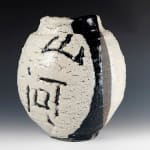Shimizu Uichi 清水 卯一 Japanese, 1926-2004
H25.4 x W21.0 x D17.7 cm
Designated LNT in 1985
Further images
-
(View a larger image of thumbnail 1
)

-
(View a larger image of thumbnail 2
)

-
(View a larger image of thumbnail 3
)

-
(View a larger image of thumbnail 4
)

-
(View a larger image of thumbnail 5
)

-
(View a larger image of thumbnail 6
)

-
(View a larger image of thumbnail 7
)

-
(View a larger image of thumbnail 8
)

-
(View a larger image of thumbnail 9
)

-
(View a larger image of thumbnail 10
)

-
(View a larger image of thumbnail 11
)

-
(View a larger image of thumbnail 12
)

Shimizu Uichi was designated a Living National Treasure for his masterful use of iron-containing glazes (tetsu-yu). His predecessor in this honor was the esteemed Ishiguro Munemaro (1893–1968), one of the original artists named in the inaugural 1955 group. While iron glazes traditionally evoke deep black or brown hues, Shimizu expanded their potential, producing luminous shades of orange, white, and even the technically difficult glaze of blue-green celadon. Like the Mingei master Shōji Hamada, Shimizu drew inspiration from the glazes of Northern Song dynasty ceramics—but in his hands, these historical techniques were transformed. He modernized them, applying them to elegant, contemporary forms that redefined how such glazes could function. Rather than serving a merely decorative or functional role, the glaze in Shimizu’s work becomes the central expressive element. This jar features the characters for “Mountain” (Yama, 山) and “River” (Kawa, 河), carved into the thick white glaze in the manner of finger-painted calligraphy. Evocative and tactile, the piece evokes the tradition of word-painting, where text and image merge into a single expressive gesture. In Shimizu’s work, glaze is no longer a surface treatment: It becomes the medium of meaning itself. Technique is assured; it is the expression of an idea that takes precedence in this jar.
Alongside Hayashi Yasuo, Shimizu Uichi was also a part of the avant-garde ceramicist group “Shikokai 四耕社” in the Kyoto scene during the post-war period in the 1950s and 60s. The movement permitted potters to re-conceptualize pottery outside of industry traditions of Japanese ceramics, which had been dominated by the idea that lineage- rather, potters who were children of pottery masters- granted credibility to ceramicists. Shimizu’s frank boldness rippled through the ceramics world in Japan and created fresh aesthetic values, tenets, and precedents for what permitted a ceramic art object.











